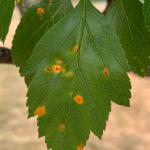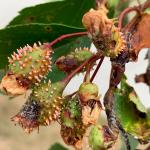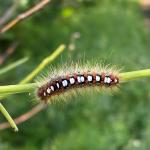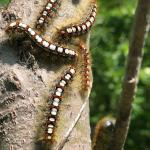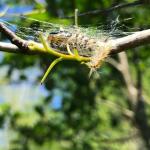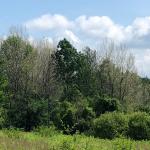UMass Extension's Landscape Message is an educational newsletter intended to inform and guide Massachusetts Green Industry professionals in the management of our collective landscape. Detailed reports from scouts and Extension specialists on growing conditions, pest activity, and cultural practices for the management of woody ornamentals, trees, and turf are regular features. The following issue has been updated to provide timely management information and the latest regional news and environmental data.
The UMass Plant Diagnostic Laboratory has reopened for plant disease, insect pest and invasive plant/weed samples. At this time, we can only accept mail-in samples, walk-in samples cannot be accepted. Please refer to our website for instructions on sample submission and to access the submission form: https://ag.umass.edu/services/plant-diagnostics-laboratory. Mail delivery services and staffing have been altered due to the pandemic, so please allow for some additional time for samples to arrive at the lab and undergo the diagnostic process. We look forward to resuming activities and diagnosing your plant problems!
The UMass Soil & Plant Nutrient Testing Lab reopened on June 23, 2020, in order to analyze samples that were in process when the lab closed on March 16 and those that arrived after that date. Orders will be processed in the order they were received. Please be aware that we will not be accepting new samples for analysis until the backlog of orders is significantly reduced. Please do not send soil samples for analysis until we are able to accept new orders. For updates and information about available services, please visit: https://ag.umass.edu/services/soil-plant-nutrient-testing-laboratory.
UMass Extension has developed a listing of resources for commercial horticulture operations in Massachusetts to help keep you informed and aware of relevant policies and best practices for landscapers, turf managers, arborists, nurseries, garden centers, and greenhouse producers.
For our COVID-19 Information and Support for Landscapers, Nurseries, Turf Managers, Garden Centers, Arborists, and Greenhouse Operations in Massachusetts, go tohttps://ag.umass.edu/landscape/news/covid-19-information-support-for-landscapers-nurseries-turf-managers-garden-centers.
To read individual sections of the message, click on the section headings below to expand the content:
Scouting Information by Region
Environmental Data
The following data was collected on or about June 24, 2020. Total accumulated growing degree days (GDD) represent the heating units above a 50° F baseline temperature collected via our instruments for the 2020 calendar year. This information is intended for use as a guide for monitoring the developmental stages of pests in your location and planning management strategies accordingly.
|
MA Region/Location |
GDD |
Soil Temp |
Precipitation
|
Time/Date of Readings |
||
|
1-Week Gain |
2020 Total |
Sun |
Shade |
|||
|
CAPE |
152 |
575 |
71 |
68 |
0.00 |
12:00 PM 6/24 |
|
SOUTHEAST |
172.5 |
665 |
87 |
72 |
0.03 |
3:45 PM 6/24 |
|
NORTH SHORE |
175 |
676 |
71 |
69 |
0.03 |
4:00 PM 6/24 |
|
EAST |
184 |
734.5 |
78 |
72 |
0.12 |
6:00 PM 6/24 |
|
METRO |
171 |
694 |
71 |
65 |
0.02 |
6:00 AM 6/24 |
|
CENTRAL |
188.5 |
701 |
66 |
63 |
0.00 |
8:30 AM 6/24 |
|
PIONEER VALLEY |
178.5 |
716.5 |
74 |
66 |
0.00 |
10:00 AM 6/24 |
|
BERKSHIRES |
165.5 |
637 |
72 |
67 |
0.71 |
9:00 AM 6/24 |
|
AVERAGE |
173 |
675 |
74 |
68 |
0.11 |
_ |
|
n/a = information not available |
||||||
Updated on 6/23, this map of MA shows a "Moderate Drought" (D1) covers half of our state and a large swath including Boston continues to experience "Abnormally Dry" (D0) conditions: https://droughtmonitor.unl.edu/CurrentMap/StateDroughtMonitor.aspx?MA
To track water use restrictions by town, regularly check the MassDEP map: https://www.mass.gov/doc/water-use-restrictions-map/download
Phenology
| Indicator Plants - Stages of Flowering (BEGIN, BEGIN/FULL, FULL, FULL/END, END) | ||||||||
|---|---|---|---|---|---|---|---|---|
|
PLANT |
CAPE |
SE |
NS |
EAST |
METRO |
CENT |
PV |
BERK |
|
Itea virginica (Virginia sweetspire) |
Begin |
* |
Begin |
Full |
* |
Begin |
Begin |
* |
|
Rhus typhina (staghorn sumac) |
* |
Full |
* |
Begin |
* |
Begin/Full |
Begin/Full |
* |
|
Hydrangea macrophylla (bigleaf Hydrangea) |
* |
Begin |
* |
Begin |
Begin/Full |
Begin/Full |
Begin/Full |
Begin |
|
Hydrangea arborescens (smooth Hydrangea) |
* |
* |
* |
Begin |
Full |
Begin |
Begin/Full |
Begin |
|
Sambucus canadensis (American elderberry) |
Begin |
Full |
Full |
Full |
Full |
Full |
Full/End |
Begin |
|
Ligustrum spp. (privet) |
Begin/Full |
Full |
Full |
Full |
Full |
Full |
Full |
Begin/Full |
|
Catalpa speciosa (northern Catalpa) |
Begin |
Full |
Full |
Full |
Full |
Begin |
Full/End |
Full |
|
Cotinus coggygria (common smokebush) |
Full |
Full |
Full |
Full |
End |
Begin/Full |
Full/End |
Full/End |
|
Hydrangea anomala petiolaris (climbing Hydrangea) |
Full |
Full/End |
Full |
Full |
Full/End |
Full |
Full/End |
Full/End |
|
Kalmia latifolia (mountain laurel) |
Full/End |
End |
End |
Full/End |
Full/End |
End |
Full/End |
Full/End |
|
Cornus kousa (Kousa dogwood) |
Full |
Full/End |
Full |
Full/End |
End |
Full |
Full/End |
Full |
| * = no activity to report/information not available | ||||||||
Regional Notes
Cape Cod Region (Barnstable)
General Conditions: The average temperature for the period from June 17 to June 24 was 70˚F with a high of 85˚F on June 20 and a low of 55˚F on June 18. Overall, the week was dominated by warm to hot, mostly sunny days with a southwest breeze. During the period no precipitation fell. Since April 1 there has been less than 6 inches of precipitation and about a half inch in the month of June. Topsoil moisture conditions are very short and subsoil moisture conditions short. Drought stress in the landscape is starting to become more evident – unirrigated lawns have browned out or will do so shortly. Some woody ornamentals, particularly dogwoods, are showing leaf curl and some scorch as a result of hot windy days and low soil moisture.
Pests/Problems: White Pine Needle Disease (WPND) is severe this year with extensive needle loss on many white pines in the area. Some cankerworm defoliation was experienced in the upper Cape region. Lecanium scale is in the egg stage protected under adult female bodies. Other insect or insect damage observed this past week include black turpentine beetle damage to pitch pine, rose slug sawfly larvae on rose, Viburnum leaf beetle damage on arrowwood Viburnum, Hibiscus sawfly larvae on Hibiscus, aphids on Viburnum, azalea lacebug on ‘PJM’ Rhododendron, hemlock wooly adelgid on hemlock, hemlock elongate scale on hemlock, Hydrangea leaftier damage (pupa present) on panicle Hydrangea, ambrosia beetle damage on katsura, eriophyid mites on Prunus species, linden and hickory. Disease symptoms and signs seen during the past week include brown rot on ‘Kwanzan’ cherry, anthracnose on sycamore (finally beginning to recover), apple scab on crabapple, leaf spot on sourwood, Cercospora on Hydrangea macrophylla, previous leafminer damage on boxwood, Volutella on boxwood, powdery mildew on Phlox, and root rot on catmint, holly, and Japanese maple. The hot weather combined with low soil moisture has caused fairly quick collapses of plants suffering from various types of root rot. Weeds in bloom include multiflora rosa (Rosa multiflora), white clover (Trifolium repens), hawkweed (Hieracium spp.), yellow wood sorrel (Oxalis stricta), curly dock (Rumex crispus), fleabane (Erigeron annuus), and sheep sorrel (Rumex acetosella). Dry conditions have kept mosquito annoyances low. Rabbits are abundant. Keep yourself protected from ticks by treating footwear and pants with permethrin.
Southeast Region (Dighton)
General Conditions: We've had heat and humidity but very little rain as we transition into summer. Although we had passing showers, my rain gauge has almost nothing to show for it. Drought stress is obvious on unirrigated turf, especially where the soil is shallow or south facing. Stressed lawns are going dormant. Among the plants currently flowering, I've noticed: Rhododendron viscosum (swamp white azalea), R. catawbiense (Catawba Rhododendron), Clethra alnifolia (summersweet), Asclepias incarnata (swamp milkweed), A. syriaca (common milkweed), Leucanthemum x superbum (Shasta daisy), Achillea millefolium (yarrow), Sambucus canadensis (elderberry), Tradescantia virginiana (Virginia spiderwort), Digitalis purpurea (foxglove), Nepeta spp.(catmint), Campanula rotundifolia (harebell/Scottish bluebell), Baptisia australis (blue false indigo), Papaver somniferum (breadseed poppy/opium poppy), P. nudicaule (Iceland poppy), Cornus kousa (Chinese dogwood), Rosa spp. (rose), Verbascum thapsus (common mullein), Commelina communis (Asiatic dayflower), Medicago lupulina (black medic), Hieracium lachenalia (common hawkweed), Astilbe spp. (false goat’s beard), Penstemon digitalis (beardtongue), Hemerocallis spp. (daylily), Hydrangea paniculata (lacecap Hydrangea), H. quercifolia (oakleaf Hydrangea), H. anomala petiolaris (climbing Hydrangea), Ilex glabra (inkberry), I. verticillata (winterberry), Kalmia latifolia (mountain laurel), Potentilla fruticosa (shrubby cinquefoil), Ligustrum spp.(privet), Ailanthus altissima (Tree of Heaven), Weigela spp. (Weigela), Physocarpus spp.( ninebark), Spirea spp. (Spirea), Syringa reticulata (tree lilac), Lonicera sempervirens (trumpet honeysuckle), L. japonica (Japanese honeysuckle), Aruncus aethusifolius (goat's beard), Oneothera spp. (evening-primrose/sundrops), Hosta spp. (Hosta), Coreopsis spp. (tickseed), Philadelphus coronarius (mock orange), Heuchera spp.(coral bells), Stachys byzantina (lamb’s-ear), Dianthus spp. (pinks), Hypercium perforatum (St. John's wort), Linaria vulgaris (yellow toadflax/butter’n’eggs), Cotinus coggygria (smoke bush), Rhus copallinum (winged sumac) and R. typhina (staghorn sumac).
Pests/Problems: Noted in the Southeast Region were fall webworm on elderberry, leaf fall due to ash rust caused by the fungus Puccinia sparganioides, columbine leafminer, Clematis wilt, redthread on a newly established lawn and drought, drought, and more drought.
North Shore (Beverly)
General Conditions: Dry and hot conditions continued during this reporting period. Extremely minimal precipitation was received when a fast-moving thunderstorm came through on the night of Wednesday June 24 and dropped just 0.03 inches of rain. The weather conditions during this period have been quite dry with very little cloud cover. The average daily temperature for this period was 74℉ with the maximum temperature of 91℉ recorded on June 20 and the minimum temperature of 67℉ recorded on June 17. Humidity was low for most days except for the last few days of this reporting period when humidity started to increase. Several plant species were observed in bloom at Long Hill; woody plants in bloom include mountain laurel (Kalmia latifolia), Chinese dogwood (Cornus kousa), Stewartia (Stewartia ovata), Weigela (Weigela florida), silver bells (Styrax japonicus), fringe tree (Chionanthus virginicus), Japanese Hydrangea vine (Schizophragma hydrangeoides), winterberry (Ilex verticillata), American smoketree (Cotinus obovatus), and elderberry (Sambucus canadensis). Herbaceous plants observed in bloom include garden peony (Paeonia lactiflora), daylilies (Hemerocallis spp.), goat’s beard (Aruncus dioicus), foxglove (Digitalis purpurea), spiderwort (Tradescantia paxata), cranesbill (Geranium spp.), water lilies (Nymphaea spp.) and roses (Rosa spp.)
Pests/Problems: Soils are very dry. Unirrigated turf on exposed lawns has turned brown due to drought conditions. Deer browsing continues to be observed on Hosta and other plants. Fern fronds were rolled in balls at the tip by the fern leaf leaftier caterpillar (Herpetogramma sp). The caterpillars feed on the innermost fronds within those protective ball-like structures. Eastern tent caterpillars were also observed on beach plum. The caterpillars inside the tents were large. Ticks and mosquitoes continue to be very active. Protect yourself with a repellent when working outdoors. The eyed elater - also known as the eastern eyed click beetle (Alaus oculatus) - was observed, but please preserve this native beetle because its larvae are voracious predators of certain wood boring beetle larvae found in decaying logs. Although they are not specifically beneficial insects (in that they kill pest insects), they are not pests themselves.
East Region (Boston)
General Conditions: Meteorological summer began hot and humid. We experienced temperatures above 90°F on both June 20 and 21, hitting 93°F and 94°F respectively. This was the first time Boston has felt temperatures in the 90’s since September 23, 2019. High temperatures ranged from 76°F to 94°F, averaging 87°F, while low temperatures ranged from 48°F to 68°F, averaging 62°F. We gained 184 GDDs, bringing the total to 734.5 GDDs. Unirrigated soils are extremely dry. We received thunderstorms on June 21 and June 24. Total rainfall for this past week varied depending on your exact location. The Weld Hill weather station recorded a combined total of 0.12”, while communities in Newton recorded up to 0.75” on the 21st and insignificant rainfall on the 24th. Large Catalpas in full bloom dominate the canopy. Commonly used as a street tree, the Japanese tree lilac (Syringa reticulata) is in full bloom. Perennial borders are adding color to the landscape and - more importantly - supporting pollinator activity.
Pests/Problems: Dry soils remain a concern. The two storm fronts delivered isolated, inconsistent rainfall amounts to the area and supplemental watering is required for most landscapes since we have been classified as “abnormally dry” by the U.S. Drought Monitor for many days. Scale and aphids continue to be observed in abundance. Many crabapples previously stressed from fungal attack continue to appear stressed with yellowing, underdeveloped foliage. Roses are suffering from a variety of pests and diseases. Curled rose sawfly (Allantus cinctus) and roseslug sawfly (Endelomyia aethiops) larvae are defoliating roses until only the midrib remains or foliage is brown with a windowpane appearance, respectively. Crabgrass (Digitaria sp.) is thriving in the hot, dry conditions. Japanese knotweed (Fallopia japonica synonyms Polygonum cuspidatum/Reynoutria japonica) is 4-6 feet tall in unmanaged settings. (See Weed report below.)
Metro West (Acton)
General Conditions: The first week of summer brought with it hot and humid mid-summer-like weather. Our first heat wave of the season began on the 19th with a temperature of 90°F, followed by temperatures of 93°F and 95°F. A temperature of 93°F was recorded 2 days later on the 23rd. For June, the monthly average precipitation is 3.93” but a meager 0.65” of rain has been recorded for this month so far. Observed in some stage of bloom this past week were the following woody plants: Buddleia spp. (butterfly-bush), Calycanthus floridus (Carolina allspice), Catalpa speciosa (northern Catalpa), Cornus sericea (redosier dogwood), Hydrangea arborescens (smooth Hydrangea), H. quercifolia (oakleaf Hydrangea), Ilex glabra (inkberry), I. pendunculosa (longstalk holly), Kalmia latifolia (mountain laurel), Ligustrum spp. (privet), Liriodendron tulipifera (tulip tree), Oxydendrum arboreum (sourwood), Philadelphus coronarius (sweet mock orange), Potentilla fruiticosa (Potentilla), Rhododendron spp., Rosa gallica (French rose), R. 'Knockout' (knockout family of roses), Rosa rugosa (beach rose), Rosa spp. (rose), Rubus spp. (bramble, blackberry), Sambucus canadensis (elderberry), Spiraea japonica 'Alpina' (Daphne Spirea), S. spp. (bridal wreath), Stewartia psuedocamellia (Japanese Stewartia), Syringa reticulata (Japanese tree lilac), Tilia cordata (littleleaf linden), and Weigela florida (old fashioned Weigela). Woody vines observed in bloom were: Clematis spp., Hydrangea anomala petiolaris (climbing Hydrangea), Lonicera sempirvirens (trumpet honeysuckle), and Wisteria spp.
Contributing even more color and interest to the landscape are some flowering herbaceous plants including: Achillea millefolium (yarrow), Alchemilla mollis (lady's mantle), Allium spp. (ornamental flowering onion), Aruncus aethusifolius (dwarf goat’s beard), A. dioicus (goat’s beard), Astilbe spp. (false Spirea), Campanula persicifolia (peach-leafed bell flower), C. takesimana ‘Elizabeth’ (bell flower), Chrysogonum virginianum (green and gold), Clematis recta 'Purpurea' (Clematis), Delphinium spp. (larkspur), Coreopsis spp. (tickseed), Dicentra eximia (fringed bleeding heart), Dictamnus albus (gas plant), Digitalis purpurea (foxglove), Filipendula spp. (meadow sweet), Geranium cantabrigiense 'Biokovo' and 'Cambridge' (hardy cranesbill), G. macrorrhizum (bigroot Geranium), G. sanguineum (bloody cranesbill), G. ‘Johnson’s Blue’ (cranesbill), Hemerocallis fulva (orange daylily), H. 'Stella D'Oro', (daylily), H. spp. (daylily), Heuchera spp. (coral bells), Hosta spp. (plantain lily), Iris versicolor (blue flag iris), Leucanthemum x superbum (Shasta daisy), Lilium spp. (lily), Lychnis coronaria (rose campion), Lupinus' 'Russell Woodfield Hybrids' (lupine), Oenothera macrocarpa (Ozark sundrops/Missouri evening primrose), Nepeta spp. (ornamental catmint), Paeonia spp. (peony), Penstemon digitalis 'Huskers Red' (beardtongue), Salvia nemerosa (Salvia), Sedum kamschaticum (Russian stonecrop), Stachys byzantina (lamb’s ear), Thermopsis caroliniana syn. Thermopsis villosa (southern lupine, Aaron's rod, bush pea), Thymus praecox (thyme), Tradescantia spp. (spiderwort) and Veronica spp. (speedwell).
Pests/Problems: The lack of any substantial rain continues to be of concern for not only this reporting area but for much of Massachusetts. According to the US Drought Monitor map updateded on June 23th, the Metro West area continues to experience abnormally dry soil conditions. This is of particular concern for trees and shrubs in the landscape stressed by pests, diseases and past drought. Signs of stress are apparent on trees including premature leaf drop and flagging foliage. Pine sawyer beetles have recently emerged (are often mistaken for the Asian longhorned beetle) and can be distinguished by their single white dot found at the base of the wing cover. Additionally, Asian Longhorned Beetles have yet to emerge but will soon! See the Insect Report below for more information.
Central Region (Boylston)
General Conditions: Recent weather has been just beachy - warm sunny days in the low to mid 80’s with the exception of a few hotter ones. Humidity is up, however a forgiving breeze makes it bearable. Many plants are in bloom, including Asclepias syriaca (common milkweed), Sambucus nigra (black elderberry), Ilex glabra (inkberry), Ilex verticillata (winterberry), white water lily (Nymphaea odorata), Galax urceolata syn. Galax aphylla (beetleweed, wandflower), Zenobia pulverulenta (honey-cup), Hydrangea quercifolia (oakleaf Hydrangea), Syringa reticulata (Japanese tree lilac), Rubus odoratus (purple flowering raspberry, thimbleberry) and Iris ensata (Japanese Iris) in varieties like ‘Geisha Girl’ & ’Pink Lady’.
Pests/Problems: Drought continues to be the biggest concern. Hopefully, rain is coming in the near future, we desperately need it. Leafy meadow plants like red clover (Trifolium pratense) and poison Ivy (Toxicodendron radicans) are dropping foliage and desiccating, while their grassy neighbors go dormant. A noticeable amount of caterpillars were found desiccated on leaves and tree bark, thankfully in the case of some which were the invasive Lymantria dispar (European gypsy moth). Otherwise, insect damage is relatively low.
Pioneer Valley Region (Easthampton)
General Conditions: Hot, humid and bone-dry best describe this past reporting period in the Pioneer Valley. Our first heat wave of 2020 took place from 6/20–6/23, as high temperatures peaked at or just above 90°F. This was coupled with dew points near 60°F, creating hot and humid conditions. Nightly lows dipped in the mid-60s, providing only minimal relief. Winds were mostly stagnant until 6/23 when gusts >20 mph were recorded at Barnes Airport in Westfield. A chance of thunderstorms on 6/24 was false hope as the storms tracked west and north while dew points hovered at 70°F, creating a swampy, thick air mass. So far this month, there’s been <0.75″ of rainfall recorded, and coupled with the recent heat wave, soils are extremely dry. The last measurable precipitation occurred on 6/11, almost two weeks ago at the time of writing. Since the soaking rain we received on 4/30–5/1, there’s been less than 1.75″ of rain recorded over a nearly eight-week period. Supplemental watering is becoming a tedious affair as mulch and soils rapidly absorb water, requiring extended periods of irrigation to ensure the root zone is wetted. Lawns are continuing to brown and go dormant and mowing cycles can be easily skipped at this point. Watering restrictions are taking effect in many cities and towns in an effort to conserve municipal water supplies. An updated DEP map of locations with watering bans in effect can be found here: https://www.mass.gov/doc/water-use-restrictions-map/download. Despite the dry and hot conditions, many trees and shrubs appear lush and vibrant at this time. New leaf and shoot growth has been observed on silver maple, black birch, crabapple, eastern hemlock, pin oak, katsura and redbud. However, wilting of perennials and new growth on some Rhododendrons has also been observed. More wilting and drought-induced dieback is inevitable at this point as the summer continues.
Pests/Problems: Oriental beetles (Anomala orientalis) have emerged, often the first of the destructive trio that includes the Japanese beetle (Popillia japonica) and Asiatic garden beetle (Maladera castanea). Do your part and help rid the landscape of these invasive, obnoxious insect pests. Reports of crabapple leaf shedding are coming in and while some is due to apple scab (Venturia inaequalis), some appears unrelated. Scab-resistant crabapples on the UMass campus are shedding many older, yellowing leaves. It’s possible the dry conditions and/or the mid-April frost/freeze events are playing some role. White pines suffering from needle blight and other health issues continue to look terrible, although as new growth develops they will appear less so. Needle blight is responsible for a significant amount of the needle yellowing and shedding that’s visible right now. Infections that took place in 2019 are resulting in this year’s needle loss. Oak anthracnose (Apiognomonia errabunda) has been observed on landscape trees but the damage appears minor to moderate. A severe lace bug (Corythucha sp.) infestation was detected on scattered landscape oaks and spider mite populations appear to be building on oaks with the warm and dry conditions. Eriophyid mites that cause galls and distortion on the leaves of deciduous trees and shrubs are very common right now and were observed on groundcover sumac, maple and elm. Both hawthorn rust (Gymnosporangium globosum) and cedar-quince rust (G. clavipes) were visible on landscape hawthorns. The former is much less of a concern than the latter, which causes fruit distortion/blight and shoot deformations (see pictures below). Honeylocust plant bug (Diaphnocoris chlorionis) damage can be readily found but typically this pest causes only minor issues for these trees. Sycamores are continuing to flush healthy leaves and canopies are rapidly filling out. Typically anthracnose keeps sycamores barren while all other trees have fully leafed-out. Assessing the fullness of the sycamore canopy at the end of June to early July is a good time to distinguish between a normal anthracnose year (2020) and a severe anthracnose year (2019). Flowering dogwoods (Cornus florida) seem to be benefiting from the dry start to summer as dogwood anthracnose is inhibited. Powdery mildew was also seen on flowering dogwood.
Berkshire Region (Great Barrington)
General Conditions: One rarely thinks of a thunderstorm and “gully washer” as being welcomed but with the precipitation deficit year-to-date (1/1-6/23) reaching 6 ½ inches, as recorded at the Pittsfield Airport, the brief storm at 4am on Wednesday, 6/24, was welcomed. Though brief, it did drop 0.71 inches of rain. Considering how dry soils had become, it remains to be seen how much impact that rain will have. Lawns, in particular, have been showing the effects of the drought. Day time temperatures over the week from 6/17 to 6/23 were mostly in the upper 80s with a record high of 88˚F set at the Pittsfield Airport on Monday 6/22. The high temperature that same day in West Stockbridge was 91˚F. Whew! It was a difficult time for outdoor workers. Because they get so involved in their work, it’s easy for heat stress to overtake them before they are aware of it. So, it’s important to recognize the symptoms of heat stress and the more serious condition of heat stroke. Get information on heat related illnesses at your doctor’s office or from this web site: https://www.aafp.org/afp/2019/0415/p482.html . Until the recent rain, relatively humidity was not much of an issue but it has noticeably increased.
Pests/Problems: As mentioned last week, the dry conditions have slowed disease development. Plant wilt is not uncommon but, in most cases, it relates to drought conditions, especially where irrigation is not possible. However, the dry conditions have accelerated dieback on many trees which were already infected with disease such as Verticillium Wilt. Diseases which continue to be apparent include black spot on roses, apple scab, needle cast, and leaf spots on maples. Leaf galls, particularly oak leaf gall, are common. Insect activity also seems somewhat limited. Though the peak is well past, a few adult flies of boxwood leaf miner could still be seen flitting about when the shrubs were disturbed. Willow leaf beetle adults and larvae continue to be present on willow foliage. Elongate hemlock scale was found on hemlock needles. Leaf miners are present on many herbaceous and woody species but the numbers are limited. The population of plant browsers is high, especially chipmunks, woodchucks and rabbits.
Regional Scouting Credits
- CAPE COD REGION - Russell Norton, Horticulture and Agriculture Educator with Cape Cod Cooperative Extension, reporting from Barnstable.
- SOUTHEAST REGION - Brian McMahon, Arborist, reporting from the Dighton area.
- NORTH SHORE REGION - Geoffrey Njue, Green Industry Specialist, UMass Extension, reporting from the Long Hill Reservation, Beverly.
- EAST REGION - Kit Ganshaw & Sue Pfeiffer, Horticulturists reporting from the Boston area.
- METRO WEST REGION – Julie Coop, Forester, Massachusetts Department of Conservation & Recreation, reporting from Acton.
- CENTRAL REGION - Mark Richardson, Director of Horticulture reporting from Tower Hill Botanic Garden, Boylston.
- PIONEER VALLEY REGION - Nick Brazee, Plant Pathologist, UMass Extension Plant Diagnostic Lab, temporarily reporting from Easthampton.
- BERKSHIRE REGION - Ron Kujawski, Horticultural Consultant, reporting from Great Barrington.
Woody Ornamentals
Diseases
The UMass Plant Diagnostic Laboratory has reopened, as of Monday 6/22. We can only accept mail-in samples at this time and with mail service to campus buildings interrupted, it may take a bit longer than usual to receive and process samples. We are excited to resume our diagnostic services of insect pest and pathogen problems. Submission forms and instructions for submitting plant material can be found here: https://ag.umass.edu/services/plant-diagnostics-laboratory.
Possible reports of Beech Leaf Disease (BLD) on both American (Fagus grandifolia) and European (F. sylvatica) continue to emerge, primarily in coastal areas of Massachusetts. Please report any potential sightings with photos of the symptomatic foliage. High-quality photos should be captured while viewing the leaves from below with the leaves backlit against the sky or a light source. The primary symptom of BLD is dark green, interveinal banding on the foliage. Additional symptoms include curling and distortion of the foliage and premature leaf shedding. Leaf shedding is an advanced symptom and may not have yet developed on some trees. Interveinal leaf yellowing may be in response to a nutrient deficiency. Other diseases or insect infestations that may be confused for BLD include beech anthracnose, woolly beech aphid, and erineum gall mites.
Crabapples and other rosaceous plants, such as cherry and serviceberry, have been observed shedding many older, yellow leaves. For crabapples, apple scab is certainly a factor in premature leaf shedding but the disease is not present in all cases and doesn’t apply to other rosaceous plants. It’s unclear if some type of winter injury due to the mild weather or the mid- to late April freeze events are playing some role. Below-freezing temperatures in mid- to late April are not uncommon in the region but because March was so abnormally warm (temperatures were 3–7°F above normal across the state), plants may have broken dormancy early and were more susceptible to cold injury than normal. A number of other landscape trees and shrubs, spanning a variety of different genera, have distorted and malformed foliage. It’s not clear what has caused these injuries in most cases and chemicals can be ruled out in almost all of the settings, suggesting some type of environmental stress is responsible.
Report by Nick Brazee, Plant Pathologist, UMass Extension Plant Diagnostic Lab, UMass Amherst.
Insects
Don’t Miss the LAST Opportunity for Online Learning about Invasive Insects in this Webinar Series!
Join UMass Extension’s Landscape, Nursery, and Urban Forestry Program and UMass Extension’s Fruit Program for an exciting FREE series of seven webinars focusing on the impact, monitoring, and management of invasive insects in Massachusetts and the nation! Topics include the spotted lanternfly, spotted wing drosophila, brown marmorated stink bug, emerald ash borer, gypsy moth, Asian longhorned beetle, and more! The final webinar in this series will be held from Noon-1:00 PM on June 30, 2020. This webinar offers 1 pesticide credit (categories 29, 35, 36, and applicators (core)) and MCA/MCLP’s earn 0.5 education credits for each webinar. ISA and SAF credits are available.
The FINAL webinar in this series will happen LIVE on:
Tuesday, June 30, 2020
Invasive Insects of Trees and Shrubs in Massachusetts: 2020 Updates
Tawny Simisky, Entomologist, UMass Extension Landscape, Nursery, and Urban Forestry Program
This presentation will provide a brief overview of current updates on the status of many invasive insect pests of trees and shrubs in Massachusetts. Species discussed will include gypsy moth, winter moth, emerald ash borer, Asian longhorned beetle, and a quick mention of the spotted lanternfly. Management information will be mentioned, with an emphasis on natural enemies and biological control.
Don’t miss this excellent opportunity! For more information about all of the webinars in this series, to register, and to see archived recordings for any that you missed, visit: https://ag.umass.edu/landscape/education-events/invasive-insect-webinars
Insects and Other Arthropods of Public Health Concern:
- Deer Tick/Blacklegged Tick: Check out the archived FREE TickTalk with TickReport webinars available here: https://ag.umass.edu/landscape/education-events/webinars . Previous webinars including information about deer ticks and associated diseases, ticks and personal protection, and updates from the Laboratory of Medical Zoology are archived at the link above.
The next webinar will be held on July 8, 2020: Biology of Powassan and Other Tick-Borne Viruses
Dr. Stephen Rich, Professor of Microbiology and Director of the UMass Laboratory of Medical Zoology, and Dr. Saravanan Thangamani, Professor of Microbiology and Immunology at Upstate Medical University in Syracuse, NY discuss what is currently known about tick-borne viruses, including Powassan virus. Dr. Thangamani studies the serosurveillance of vector-borne (tick and mosquito) diseases including the effect of co-infection on the clinical outcome of Lyme disease and Powassan encephalitis.
Ixodes scapularis nymphs (immatures) are active, and may be encountered at this time, through August. Nymphs will have already taken a blood meal, and therefore can be infected with disease causing pathogens. It is important to protect yourself against ticks and be especially vigilant for tiny, difficult to see nymphs. For images of all deer tick life stages, along with an outline of the diseases they carry, visit: http://www.tickencounter.org/tick_identification/deer_tick .
Anyone working in the yard and garden should be aware that there is the potential to encounter deer ticks. The deer tick or blacklegged tick can transmit Lyme disease, human babesiosis, human anaplasmosis, and other diseases. Preventative activities, such as daily tick checks, wearing appropriate clothing, and permethrin treatments for clothing (according to label instructions) can aid in reducing the risk that a tick will become attached to your body. If a tick cannot attach and feed, it will not transmit disease. For more information about personal protective measures, visit: http://www.tickencounter.org/prevention/protect_yourself .
Have you just removed an attached tick from yourself or a loved one with a pair of tweezers? If so, consider sending the tick to the UMass Laboratory of Medical Zoology to be tested for disease causing pathogens. To submit a tick to be tested, visit: https://www.tickreport.com/ and click on the blue “Order a TickReport” button. Results are typically available within 3 business days, or less. By the time you make an appointment with your physician following the tick attachment, you may have the results back from TickReport to bring to your physician to aid in a conversation about risk.
The UMass Laboratory of Medical Zoology does not give medical advice, nor are the results of their tests diagnostic of human disease. Transmission of a pathogen from the tick to you is dependent upon how long the tick had been feeding, and each pathogen has its own transmission time. TickReport is an excellent measure of exposure risk for the tick (or ticks) that you send in to be tested. Feel free to print out and share your TickReport with your healthcare provider.
- Mosquitoes: According to the Massachusetts Bureau of Infectious Disease and Laboratory Science and the Department of Public Health, there are at least 51 different species of mosquito found in Massachusetts. Mosquitoes belong to the Order Diptera (true flies) and the Family Culicidae (mosquitoes). As such, they undergo complete metamorphosis, and possess four major life stages: egg, larva, pupa, and adult. Adult mosquitoes are the only stage that flies and many female mosquitoes only live for 2 weeks (although the life cycle and timing will depend upon the species). Only female mosquitoes bite to take a blood meal, and this is so they can make eggs. Mosquitoes need water to lay their eggs in, so they are often found in wet or damp locations and around plants. Different species prefer different habitats. It is possible to be bitten by a mosquito at any time of the day, and again timing depends upon the species. Many are particularly active from just before dusk, through the night, and until dawn. Mosquito bites are not only itchy and annoying, but they can be associated with greater health risks. Certain mosquitoes vector pathogens that cause diseases such as West Nile virus (WNV) and eastern equine encephalitis (EEE).
For more information about mosquitoes in Massachusetts, visit: https://www.mass.gov/service-details/mosquitoes-in-massachusetts
There are ways to protect yourself against mosquitoes, including wearing long-sleeved shirts and long pants, keeping mosquitoes outside by using tight-fitting window and door screens, and using insect repellents as directed. Products containing the active ingredients DEET, permethrin, IR3535, picaridin, and oil of lemon eucalyptus provide protection against mosquitoes.
For more information about mosquito repellents, visit: https://www.mass.gov/service-details/mosquito-repellents and https://www.cdc.gov/features/stopmosquitoes

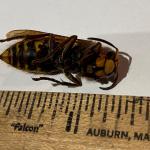 Wasps/Hornets: Many are noticing the spring time “awakening” of various species of wasps/hornets in Massachusetts at this time. Many wasps are predators of other arthropods, including pest insects such as certain caterpillars that feed on trees and shrubs. Adult wasps hunt prey and bring it back to their nest where young are being reared, as food for the immature wasps. A common such example are the paper wasps (Polistes spp.) who rear their young on chewed up insects. They may be seen searching plants for caterpillars and other soft-bodied larvae to feed their young. Paper wasps can sting, and will defend their nests, which are open-celled paper nests that are not covered with a papery “envelope”. These open-celled nests may be seen hanging from eaves or other outdoor building structures. Aerial yellow jackets and hornets create large aerial nests that are covered with a papery shell or “envelope”. Common yellow jacket species include those in the genus Vespula. Dolichovespula maculata is commonly known as the baldfaced hornet, although it is not a true hornet. The European hornet (Vespa crabro) is three times the size of a yellow jacket and may be confused for the Asian giant hornet (Vespa mandarinia). The European hornet is known to Massachusetts, but the Asian giant hornet is not. If you are concerned that you have found or photographed an Asian giant hornet, please report it here: https://massnrc.org/pests/report.aspx . A helpful ID tool, although developed for Texas by the USDA, depicts common look-a-like species that we also have in MA that can be confused for the Asian giant hornet and is found here: https://agrilife.org/lubbock/files/2020/05/Asian_Giant_Hornet_Look-alikes_101_Xanthe_Shirley.pdf
Wasps/Hornets: Many are noticing the spring time “awakening” of various species of wasps/hornets in Massachusetts at this time. Many wasps are predators of other arthropods, including pest insects such as certain caterpillars that feed on trees and shrubs. Adult wasps hunt prey and bring it back to their nest where young are being reared, as food for the immature wasps. A common such example are the paper wasps (Polistes spp.) who rear their young on chewed up insects. They may be seen searching plants for caterpillars and other soft-bodied larvae to feed their young. Paper wasps can sting, and will defend their nests, which are open-celled paper nests that are not covered with a papery “envelope”. These open-celled nests may be seen hanging from eaves or other outdoor building structures. Aerial yellow jackets and hornets create large aerial nests that are covered with a papery shell or “envelope”. Common yellow jacket species include those in the genus Vespula. Dolichovespula maculata is commonly known as the baldfaced hornet, although it is not a true hornet. The European hornet (Vespa crabro) is three times the size of a yellow jacket and may be confused for the Asian giant hornet (Vespa mandarinia). The European hornet is known to Massachusetts, but the Asian giant hornet is not. If you are concerned that you have found or photographed an Asian giant hornet, please report it here: https://massnrc.org/pests/report.aspx . A helpful ID tool, although developed for Texas by the USDA, depicts common look-a-like species that we also have in MA that can be confused for the Asian giant hornet and is found here: https://agrilife.org/lubbock/files/2020/05/Asian_Giant_Hornet_Look-alikes_101_Xanthe_Shirley.pdf
Paper wasps and aerial yellowjackets overwinter as fertilized females (queens) and a single female produces a new nest annually in the late spring. Nests are abandoned at the end of the season. It is this annual behavior of queens starting new nests, laying eggs, and rearing new wasps to assist in colony/nest development that may lead people to believe that wasp/yellow jacket numbers are high at this time of year. While populations may fluctuate and insect survival may have been aided by a mild winter (although that is not always true for all species), it is difficult to tell if these insects are more numerous this year, or just that they are more noticeable now that nest construction and brood development are under way for the season. Either way, some people are allergic to stinging insects, so care should be taken around wasp/hornet nests. Unlike the European honeybee (Apis mellifera), wasps and hornets do not have barbed stingers, and therefore can sting repeatedly when defending their nests. It is best to avoid their nests, and if that cannot be done and assistance is needed to remove them, consult a professional.
Woody ornamental insect and non-insect arthropod pests to consider, a selected few:

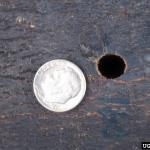
 Asian Longhorned Beetle: (Anoplophora glabripennis, ALB) was recently detected for the first time in South Carolina. Asian longhorned beetle eradication programs currently exist in Massachusetts, New York, and Ohio. A homeowner is responsible for finding, reporting, and making officials aware of the infestation in South Carolina. Great job!
Asian Longhorned Beetle: (Anoplophora glabripennis, ALB) was recently detected for the first time in South Carolina. Asian longhorned beetle eradication programs currently exist in Massachusetts, New York, and Ohio. A homeowner is responsible for finding, reporting, and making officials aware of the infestation in South Carolina. Great job!
The U.S. Department of Agriculture’s (USDA) Animal and Plant Health Inspection Service (APHIS) and the Clemson University’s Department of Plant Industry (DPI) are inspecting trees in Hollywood, South Carolina following the detection and identification of the Asian longhorned beetle (ALB).
On May 29, a homeowner in Hollywood, South Carolina contacted DPI to report they found a dead beetle on their property and suspected it was ALB. A DPI employee collected the insect the same day and conducted a preliminary survey of the trees on the property. Clemson’s Plant and Pest Diagnostic Clinic provided an initial identification of ALB, and on June 4, APHIS’ National Identification Services confirmed the insect. On June 11, APHIS and DPI inspectors confirmed that one tree on the property is infested, and a second infested tree was found on an adjacent property. For more information, visit: https://www.aphis.usda.gov/aphis/newsroom/stakeholder-info/sa_by_date/sa-2020/sa-06/alb-sc .
This is a perfectly timed reminder for us to remain vigilant, and report any suspicious beetles or damage to trees, especially maples. Asian longhorned beetle infests 12 genera of trees, however maples are preferred hosts.
Look for signs of an ALB infestation which include perfectly round exit holes (about the size of a dime), shallow oval or round scars in the bark where a female has chewed an egg site, or sawdust-like frass (excrement) on the ground nearby host trees or caught in between branches. Be advised that other, native insects may create perfectly round exit holes or sawdust-like frass, which can be confused with signs of ALB activity.
The regulated area for Asian longhorned beetle is 110 miles2 encompassing Worcester, Shrewsbury, Boylston, West Boylston, and parts of Holden and Auburn. If you believe you have seen damage caused by this insect, such as exit holes or egg sites, on susceptible host trees like maple, please call the Asian Longhorned Beetle Eradication Program office in Worcester, MA at 508-852-8090 or toll free at 1-866-702-9938.
To report an Asian longhorned beetle find online or compare it to common insect look-alikes, visit: http://massnrc.org/pests/albreport.aspx or https://www.aphis.usda.gov/pests-diseases/alb/report .
- White Spotted Pine Sawyer (WSPS): Monochamus scutellatus adults can emerge in late May throughout July, depending on local temperatures. The Asian Longhorned Beetle Eradication Program reports that white spotted pine sawyer adult beetle activity has increased recently. This is a native insect in Massachusetts and is usually not a pest. Larvae develop in weakened or recently dead conifers, particularly eastern white pine (Pinus strobus). However, the white spotted pine sawyer looks very similar to the invasive Asian Longhorned Beetle, Anoplophora glabripennis, ALB. ALB adults do not emerge in Massachusetts until July and August. Beginning in July, look for the key difference between WSPS and ALB adults, which is a white spot in the top center of the wing covers (the scutellum) on the back of the beetle. White spotted pine sawyer will have this white spot, whereas Asian longhorned beetle will not. Both insects can have other white spots on the rest of their wing covers; however, the difference in the color of the scutellum is a key characteristic. See the Asian longhorned beetle entry above for more information about that non-native insect.
- White Satin Moth: Leucoma salicis was recently reported from Beartown State Forest (Berkshire County) on 6/23/2020 by the Massachusetts Department of Conservation and Recreation, Forest Health Program. At this location, DCR estimates approximately 5-10 acres of defoliation due to the activity of this insect. Initial identification of the insect responsible for this activity was made by Marc DiGirolomo, a Forest Health Technician for the US Forest Service - Forest Health Protection (FHP) group in Durham, NH. The caterpillars of this species have a unique color pattern, which helps us distinguish them from others. The dorsal (back) side of the caterpillar is marked with 10-11 white, intersegmental spots as well as paired, red “setal warts”. The sides of the caterpillars are blueish gray. These caterpillars are known to the edges of waterways, woodlands, and forests from Canada to northwestern Connecticut and central New York. One generation occurs per year with mature caterpillars known in May and June. Host plants include aspen, poplar, and willow and are fed upon by the caterpillars of this species.
The white satin moth was introduced from Europe and first reported between Boston, MA and Hampton, New Hampshire in 1920. This insect is said to overwinter in the third instar (caterpillars pass through seven instars), either individually or in small groups. In the spring time, caterpillars leave their areas of hibernation to feed on nearby leaves. Caterpillars spin a thin cocoon between leaves or between exfoliating or thick bark crevices. Pupae are dark brown/black and often in a thin, loose silken sack. Pupae also sport brightly colored, yellow setae (hairs) that make them quite attractive. Pupation begins by the end of June. Shortly thereafter, moths emerge and females lay egg masses covered in a frothy, white material from July – mid-August. Eggs hatch sometime in August and larvae will conduct feeding in August and September.
While caterpillars of this species are not noted to be of particular concern with regard to causing allergic reactions such as dermatitis, they are a type of tussock moth and do possess hairs, so they should either not be handled or approached with caution, particularly by sensitive individuals.
- Arborvitae Leafminer: In New England and eastern Canada, four species of leafminers are known to infest arborvitae. These include Argyresthia thuiella, A. freyella, A. aureoargentella, and Coleotechnites thujaella. The arborvitae leafminer, A. thuiella, is the most abundant of these and has the greatest known range when compared to the others. (It is also found in the Mid-Atlantic States and as far west as Missouri). Moths of this species appear from mid-June to mid-July and lay their eggs. The damage caused by all of these species is nearly identical. Trees, however, have been reported to lose up to 80% of their foliage due to arborvitae leafminer and still survive. At least 27 species of parasites have been reported as natural enemies of arborvitae leafminers, the most significant of which may be a parasitic wasp (Pentacnemus bucculatricis). Arborvitae leafminer damage causes the tips of shoots and foliage to turn yellow and brown. If infestations are light, prune out infested tips.
- Azalea Bark Scale: Eriococcus azaleae was discovered in CT in 1917 and has since been reported in other states. It is found on the bark of twigs and stems and commonly settles in branch crotches. It has been reported on azalea, rhododendron, andromeda, and others. Female scales are approximately 2-3 mm. in length and covered in a white, waxy coating. The females are purple in color and may resemble a mealybug, although they are a soft or felt scale. These females have overwintered and are going to lay eggs which will hatch into crawlers toward the end of June through mid-July. Crawlers will settle into branch crotches, bark crevices, or on the axils of leaves. There is a parasitic wasp that will attack these insects. When high in number, these scales can cause yellowing of the foliage and their sugary excrement can lead to the promotion of sooty mold. Because these are soft scales, they may be targeted with horticultural oils or insecticidal soaps while observing label instructions to prevent phytotoxicity.
- Azalea Sawflies: There are a few species of sawflies that impact azaleas. Johnson and Lyon's Insects that Feed on Trees and Shrubs mentions three of them. Amauronematus azaleae was first reported in New Hampshire in 1895 and is likely found in most of New England. Adults of this species are black with some white markings and wasp-like. Generally green larvae feed mostly on mollis hybrid azaleas. Remember, sawfly caterpillars have at least enough abdominal prolegs to spell “sawfly” (so 6 or more prolegs). Adults are present in May, and females lay their eggs and then larvae hatch and feed through the end of June. There is one generation per year. Nematus lipovskyi has been reared from swamp azalea (Rhododendron viscosum). Adults of that species have been collected in April (in states to the south) and May (in New England) and larval feeding is predominantly in late April and May in Virginia and June in New England. One generation of this species occurs per year, and most mollis hybrid azaleas can be impacted. A third species, Arge clavicornis, is found as an adult in July and lays its eggs in leaf edges in rows. Larvae are present in August and September. Remember, Bacillus thuringiensis Kurstaki does not manage sawflies.
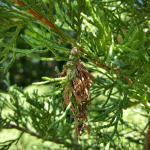 Bagworm: Thyridopteryx ephemeraeformis is a native species of moth whose larvae construct bag-like coverings over themselves with host plant leaves and twigs. This insect overwinters in the egg stage, within the bags of deceased females from last season. Eggs may hatch and young larvae are observed feeding around mid-June, or roughly between 600-900 GDD’s. Remove and destroy overwintering bags before June. In certain areas across MA in 2019, increased populations of bagworms were observed and reported. More information can be found here: https://ag.umass.edu/landscape/fact-sheets/bagworm
Bagworm: Thyridopteryx ephemeraeformis is a native species of moth whose larvae construct bag-like coverings over themselves with host plant leaves and twigs. This insect overwinters in the egg stage, within the bags of deceased females from last season. Eggs may hatch and young larvae are observed feeding around mid-June, or roughly between 600-900 GDD’s. Remove and destroy overwintering bags before June. In certain areas across MA in 2019, increased populations of bagworms were observed and reported. More information can be found here: https://ag.umass.edu/landscape/fact-sheets/bagworm- Boxwood Leafminer: Monarthropalpus flavus partly grown fly larvae overwinter in the leaves of susceptible boxwood. Yellowish mines may be noticeable on the undersides of leaves. This insect grows rapidly in the spring, transforming into an orange-colored pupa. After pupation, adults will emerge and white colored pupal cases may hang down from the underside of leaves where adults have emerged. Adults may be observed swarming hosts between 300-650 GDD’s, or roughly the end of May through June. Most cultivars of Buxus sempervirens and B. microphylla are thought to be susceptible. If installing new boxwoods this spring, resistant cultivars such as ‘Vardar Valley’ and ‘Winter Gem’ are good choices at sites where this insect has been a problem.
- Cottony Taxus Scale: Pulvinaria floccifera, also referred to as the cottony camellia scale, utilizes such hosts as taxus, camellia, holly, hydrangea, Japanese maple, euonymus, magnolia, and jasmine, among others. Females have laid the long, narrow, white and fluted egg sac that makes them much more noticeable. Eggs will hatch over an extended period of 6 weeks and crawlers may be treated between 802-1388 GDD’s. This insect can cause the host to appear off-color. They also produce honeydew which promotes sooty mold growth. Dieback is not common with this insect. Target the underside of the foliage. Horticultural oil, neem oil, and insecticidal soaps may be used to manage these soft scales. Reduced risk options help preserve natural enemies.
- Dogwood Borer: Synanthedon scitula is a species of clearwing moth whose larvae bore not only into dogwood (Cornus), but hosts also include flowering cherry, chestnut, apple, mountain ash, hickory, pecan, willow, birch, bayberry, oak, hazel, myrtle, and others. Kousa dogwood appear to be resistant to this species. Signs include the sloughing of loose bark, brown frass, particularly near bark cracks and wounds, dead branches, and adventitious growth. The timing of adult emergence can be expected when dogwood flower petals are dropping and weigela begins to bloom. Adult moth flights continue from then until September. Emergence in some hosts (ex. apple) appears to be delayed, but this differs depending upon the location in this insect’s range. Eggs are laid singly, or in small groups, on smooth and rough bark. Female moths preferentially lay eggs near wounded bark. After hatch, larvae wander until they find a suitable entrance point into the bark. This includes wounds, scars, or branch crotches. This insect may also be found in twig galls caused by other insects or fungi. Larvae feed on phloem and cambium. Fully grown larvae are white with a light brown head and approx. ½ inch long. Pheromone traps and lures are useful for determining the timing of adult moth emergence and subsequent management.
- Elm Cockscomb Gall:
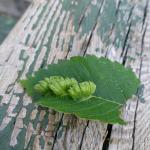 The non-native aphid Colopha ulmicola, aka the elm cockscomb aphid, produces the odd leaf structures known as the elm cockscomb gall. The galls are green and worm-like when they are first formed, but as they mature they look more and more like chicken cockscombs and eventually even turn red in color. These will rise from elm leaves and although they may be unsightly to some, like with many leaf galls the damage they cause is purely aesthetic and typically does not warrant management.
The non-native aphid Colopha ulmicola, aka the elm cockscomb aphid, produces the odd leaf structures known as the elm cockscomb gall. The galls are green and worm-like when they are first formed, but as they mature they look more and more like chicken cockscombs and eventually even turn red in color. These will rise from elm leaves and although they may be unsightly to some, like with many leaf galls the damage they cause is purely aesthetic and typically does not warrant management.
- Elongate Hemlock Scale: Fiorinia externa is found on eastern, Carolina, and Japanese hemlock, as well as yew, spruce, and fir. The elongate hemlock scale may overwinter in various life stages, and overlap of many developmental stages at any given time can be observed throughout much of the season.
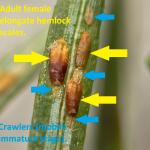 Dormant oil applications for this pest can occur according to label instructions in April, roughly between 7-120 GDD’s. Treatments for the crawler, or mobile, stage of this insect may be made in late May through mid-June, or between 360-700 GDD’s, base 50°F. Nitrogen fertilizer applications may make elongate hemlock scale infestations worse.
Dormant oil applications for this pest can occur according to label instructions in April, roughly between 7-120 GDD’s. Treatments for the crawler, or mobile, stage of this insect may be made in late May through mid-June, or between 360-700 GDD’s, base 50°F. Nitrogen fertilizer applications may make elongate hemlock scale infestations worse.
- Emerald Ash Borer: (Agrilus planipennis, EAB) As of March 2020, the Massachusetts Department of Conservation and Recreation has confirmed a total of at least 116 communities in Massachusetts that have known populations of emerald ash borer. A map of these locations across the state may be found here: https://ag.umass.edu/fact-sheets/emerald-ash-borer .
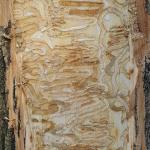
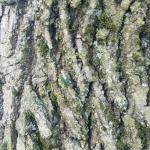
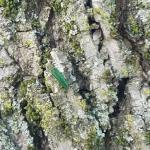
This wood-boring beetle readily attacks ash (Fraxinus spp.) including white, green, and black ash and has also been found developing in white fringe tree (Chionanthus virginicus) and has been reported in cultivated olive (Olea europaea). Adult insects of this species will not be present at this time of year. Signs of an EAB infested tree may include (at this time) D-shaped exit holes in the bark (from adult emergence in previous years), “blonding” or lighter coloration of the ash bark from woodpecker feeding (chipping away of the bark as they search for larvae beneath), and serpentine galleries visible through splits in the bark, from larval feeding beneath. Positive identification of an EAB-infested tree may not be possible with these signs individually on their own.
For further information about this insect, please visit: https://ag.umass.edu/fact-sheets/emerald-ash-borer . If you believe you have located EAB-infested ash trees, particularly in an area of Massachusetts not identified on the map provided, please report here: http://massnrc.org/pests/pestreports.htm .
 Euonymus Caterpillar: Yponomeuta cagnagella is of European origin and widespread in distribution throughout Europe. It was first reported in North America in Ontario in 1967. The euonymus caterpillars (larvae) feed in groups and envelop the foliage of the host plant in webs as they feed. Hosts include: Euonymus europaeus (tree form), E. kiautschovicus, E. alatus, and E. japonicus. Mature caterpillars are just under an inch in length, creamy yellow-gray in color with black spots and a black head capsule. By late June, these larvae pupate in white, oval-shaped cocoons which are typically oriented together vertically either on host plants or non-hosts in the area. Cocoons can be found in cracks and crevices, or webbed together leaves. The adult moth emerges in late June in most locations. The adult female secretes a gummy substance over her eggs which will harden, making them even more difficult to see. Eggs hatch by mid-August, at which time the tiny larvae prepare to overwinter beneath their eggshell-like covering. These larvae are inactive until the following year, when caterpillars group together to feed on newly emerging leaves, creating a mess of webs as they feed. There is one generation per year. Plants may be partially or entirely defoliated. Management of young, actively feeding caterpillars with Bacillus thuringiensis is possible if deemed necessary, however many species of Euonymus are considered invasive themselves.
Euonymus Caterpillar: Yponomeuta cagnagella is of European origin and widespread in distribution throughout Europe. It was first reported in North America in Ontario in 1967. The euonymus caterpillars (larvae) feed in groups and envelop the foliage of the host plant in webs as they feed. Hosts include: Euonymus europaeus (tree form), E. kiautschovicus, E. alatus, and E. japonicus. Mature caterpillars are just under an inch in length, creamy yellow-gray in color with black spots and a black head capsule. By late June, these larvae pupate in white, oval-shaped cocoons which are typically oriented together vertically either on host plants or non-hosts in the area. Cocoons can be found in cracks and crevices, or webbed together leaves. The adult moth emerges in late June in most locations. The adult female secretes a gummy substance over her eggs which will harden, making them even more difficult to see. Eggs hatch by mid-August, at which time the tiny larvae prepare to overwinter beneath their eggshell-like covering. These larvae are inactive until the following year, when caterpillars group together to feed on newly emerging leaves, creating a mess of webs as they feed. There is one generation per year. Plants may be partially or entirely defoliated. Management of young, actively feeding caterpillars with Bacillus thuringiensis is possible if deemed necessary, however many species of Euonymus are considered invasive themselves.
Want to see euonymus caterpillars in action?! I bet you’ve never seen so many of these caterpillars in one place! Check out Episode 3 of InsectXaminer: https://ag.umass.edu/landscape/education-events/insectxaminer .
- Euonymus Scale: Unaspis euonymi is an armored scale that can be found on euonymus, holly, bittersweet, and pachysandra. This insect can cause yellow spotting on leaves, dieback, and distorted bark. Dormant oil applications can be made between 35-120 GDD’s or roughly from mid-April to early-May. For crawlers, early June timing is suggested between 533-820 GDD’s. (Eggs begin to hatch in early June.)
 European Elm Scale: Gossyparia spuria is a type of felt scale and was reported to UMass Extension as active in Quincy, MA on 6/3/20. First noted in New York in 1884, this non-native scale is now widespread in North America and is found on native and European elms, but also rarely on hackberry and Zelkova. This insect can cause yellowing of foliage, premature leaf drop, and eventually dieback on its host. Honeydew and thus sooty mold are produced. The females observed in Quincy, MA have produced a ring of white fibers around their black, oval bodies. By the end of June, these females will lay eggs that hatch into bright yellow crawlers, which will disperse to the midrib and leaf veins on the underside of elm leaves where they will remain to feed. Crawlers are tiny and magnification is necessary to observe. Natural enemies such as parasitic wasps and predatory insects have been reported as successful in managing this insect.
European Elm Scale: Gossyparia spuria is a type of felt scale and was reported to UMass Extension as active in Quincy, MA on 6/3/20. First noted in New York in 1884, this non-native scale is now widespread in North America and is found on native and European elms, but also rarely on hackberry and Zelkova. This insect can cause yellowing of foliage, premature leaf drop, and eventually dieback on its host. Honeydew and thus sooty mold are produced. The females observed in Quincy, MA have produced a ring of white fibers around their black, oval bodies. By the end of June, these females will lay eggs that hatch into bright yellow crawlers, which will disperse to the midrib and leaf veins on the underside of elm leaves where they will remain to feed. Crawlers are tiny and magnification is necessary to observe. Natural enemies such as parasitic wasps and predatory insects have been reported as successful in managing this insect.
- Fall Webworm: Hyphantria cunea is native to North America and Mexico. It is now considered a world-wide pest, as it has spread throughout much of Europe and Asia. (For example, it was introduced accidentally into Hungary from North America in the 1940’s.) Hosts include nearly all shade, fruit, and ornamental trees except conifers. In the USA, at least 88 species of trees are hosts for these insects, while in Europe at least 230 species are impacted. In the past history of this pest, it was once thought that the fall webworm was a two-species complex. It is now thought that H. cunea has two color morphs – one black headed and one red headed. These two color forms differ not only in the coloration of the caterpillars and the adults, but also in their behaviors. Caterpillars may go through at least 11 molts, each stage occurring within a silken web they produce over the host. When alarmed, all caterpillars in the group will move in unison in jerking motions that may be a mechanism for self-defense. Depending upon the location and climate, 1-4 generations of fall webworm can occur per year. Fall webworm adult moths lay eggs on the underside of the leaves of host plants in the spring. These eggs hatch in late June or early July depending on climate. Young larvae feed together in groups on the undersides of leaves, first skeletonizing the leaf and then enveloping other leaves and eventually entire branches within their webs. Webs are typically found on the terminal ends of branches. All caterpillar activity occurs within this tent, which becomes filled with leaf fragments, cast skins, and frass. Fully grown larvae then wander from the webs and pupate in protected areas such as the leaf litter where they will remain for the winter. Adult fall webworm moths emerge the following spring/early summer to start the cycle over again. 50+ species of parasites and 36+ species of predators are known to attack fall webworm in North America. Fall webworms typically do not cause extensive damage to their hosts. Nests may be an aesthetic issue for some. If in reach, small fall webworm webs may be pruned out of trees and shrubs and destroyed. Do not set fire to H. cunea webs when they are still attached to the host plant.
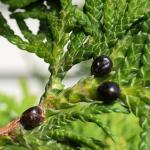
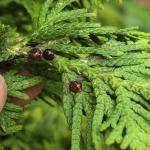 Fletcher Scale: Parthenolecanium fletcheri is a soft scale pest of yew, juniper, and arborvitae. Feeding scales, especially on yew, result in honeydew and sooty mold, needle yellowing, and at times, premature needle drop. There is one generation per year. Overwintered second instar nymphs can be targeted between 38-148 GDD’s, base 50°F. Nymphs develop and adult females lay eggs (on average 500-600) in May that hatch by June. Dead females conceal egg masses beneath. Crawlers migrate short distances to branches and may be concentrated on certain branches of a particular plant.
Fletcher Scale: Parthenolecanium fletcheri is a soft scale pest of yew, juniper, and arborvitae. Feeding scales, especially on yew, result in honeydew and sooty mold, needle yellowing, and at times, premature needle drop. There is one generation per year. Overwintered second instar nymphs can be targeted between 38-148 GDD’s, base 50°F. Nymphs develop and adult females lay eggs (on average 500-600) in May that hatch by June. Dead females conceal egg masses beneath. Crawlers migrate short distances to branches and may be concentrated on certain branches of a particular plant.
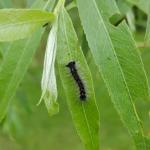 Gypsy Moth:(Lymantria dispar) thanks to the gypsy moth caterpillar killing fungus, Entomophaga maimaiga, the recent outbreak of gypsy moth in Massachusetts has come to an end! Most locations in Massachusetts will not see damaging or even noticeable populations of this insect in 2020. However, that does not mean the occasional egg mass won’t be seen in certain areas of the state. Egg hatch was observed and reported with photo evidence in Shelburne Falls, MA on 5/4/2020.Shadbush (Amelanchier spp.) was reported as in full bloom at the same time in that area. A young gypsy moth caterpillar was seen feeding on willow in Chesterfield, MA on 6/3/20, despite the relative lack of overwintering gypsy moth egg masses in the area. The impact of gypsy moth in this particular hilltown in Hampshire County has been negligible.
Gypsy Moth:(Lymantria dispar) thanks to the gypsy moth caterpillar killing fungus, Entomophaga maimaiga, the recent outbreak of gypsy moth in Massachusetts has come to an end! Most locations in Massachusetts will not see damaging or even noticeable populations of this insect in 2020. However, that does not mean the occasional egg mass won’t be seen in certain areas of the state. Egg hatch was observed and reported with photo evidence in Shelburne Falls, MA on 5/4/2020.Shadbush (Amelanchier spp.) was reported as in full bloom at the same time in that area. A young gypsy moth caterpillar was seen feeding on willow in Chesterfield, MA on 6/3/20, despite the relative lack of overwintering gypsy moth egg masses in the area. The impact of gypsy moth in this particular hilltown in Hampshire County has been negligible.
Gypsy moth has been in Massachusetts since the 1860's. This invasive insect from Europe often goes unnoticed, thanks to population regulation provided by the entomopathogenic fungus, E. maimaiga, as well as a NPV virus specific to gypsy moth caterpillars. (And to a lesser extent many other organisms, including other insects, small mammals, and birds who feed on gypsy moth.) However, if environmental conditions do not favor the life cycle of the fungus, outbreaks of gypsy moth caterpillars are possible. (Such as most recently from 2015-2018, with a peak in the gypsy moth population in 2017 in Massachusetts.)
Missing gypsy moth already? Check out Episode 1 of InsectXaminer to reminisce about the 2015-2018 outbreak of this insect: https://ag.umass.edu/landscape/education-events/insectxaminer
- Hemlock Looper: Two species of geometrid moths in the genus Lambdina are native insects capable of defoliating eastern hemlock, balsam fir, and white spruce. Adult moths lay their eggs on the trunk and limbs of hosts in September and October, and eggs will hatch by late May or early June. (L. fiscellaria caterpillars may be active between 448-707 GDD’s.) Monitor susceptible hosts for small, inch-worm like caterpillars. Where populations are low, no management is necessary. Hemlock loopers have several effective natural enemies.
- Hemlock Woolly Adelgid: Adelges tsugae is present on eastern and Carolina hemlock. The overwintering hemlock woolly adelgid generation (sistens) is present through mid-spring and produces the spring generation (progrediens) which will be present from early spring through mid-summer. HWA, unlike many other insects, does most of its feeding over the winter. Eggs may be found in woolly masses at the base of hemlock needles beginning in mid-March. Each woolly mass is created by a female who may then lay 50-300 eggs. Eggs hatch and crawlers may be found from mid-March through mid-July. Infested trees may be treated with foliar sprays in late April to early May, using Japanese quince as a phenological indicator. Systemic applications may be made in the spring and fall, or when soil conditions are favorable for translocation to foliage. Nitrogen fertilizer applications may make hemlock woolly adelgid infestations worse.
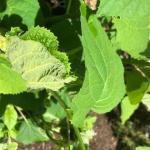
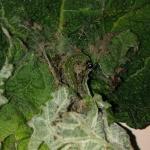 Hydrangea Leaftier: Olethreutes ferriferana is a moth in the Family Tortricidae whose caterpillars use silk applied to the edges of two newly expanding hydrangea leaves to tie them together to create an envelope-like structure within which they feed. These leaf-envelopes tend to occur near the tips of plant stems and can be very obvious. As a result, the two tied leaves may not fully expand when compared to healthy, not impacted leaves. Caterpillars are green and partially transparent with a black head capsule and a black thoracic shield which is found on the top of the body segment located directly behind the head. It is likely that caterpillars will soon be pupating. Pupation is thought to occur in the ground nearby host plants, so the insect drops to the ground to pupate where it overwinters. Adults are found in the spring and are small white and brown moths. Eggs are laid on branch tips of various species of hydrangea. Only one generation is known per year. This insect, although creating visible and interesting damage to hydrangea, is not usually considered to be a serious pest – although occasional localized problematic populations have been reported. Removing leaf-envelopes in the early spring or pinching them to kill the caterpillar within can help reduce populations on individual plants.
Hydrangea Leaftier: Olethreutes ferriferana is a moth in the Family Tortricidae whose caterpillars use silk applied to the edges of two newly expanding hydrangea leaves to tie them together to create an envelope-like structure within which they feed. These leaf-envelopes tend to occur near the tips of plant stems and can be very obvious. As a result, the two tied leaves may not fully expand when compared to healthy, not impacted leaves. Caterpillars are green and partially transparent with a black head capsule and a black thoracic shield which is found on the top of the body segment located directly behind the head. It is likely that caterpillars will soon be pupating. Pupation is thought to occur in the ground nearby host plants, so the insect drops to the ground to pupate where it overwinters. Adults are found in the spring and are small white and brown moths. Eggs are laid on branch tips of various species of hydrangea. Only one generation is known per year. This insect, although creating visible and interesting damage to hydrangea, is not usually considered to be a serious pest – although occasional localized problematic populations have been reported. Removing leaf-envelopes in the early spring or pinching them to kill the caterpillar within can help reduce populations on individual plants.
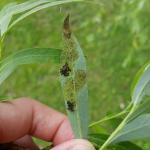
Imported Willow Leaf Beetle: Plagiodera versicolora adult beetles overwinter near susceptible hosts. Adult beetles will chew holes and notches in the leaves of willow once they become available. Imported willow leaf beetle adults were observed feeding and mating in Chesterfield, MA on 5/20/2020. Adults continued to feed and mate on 5/26/2020 and egg laying has been observed. Females lay yellow eggs in clusters on the undersides of leaves. While clusters of yellow eggs could still be found, tiny larvae hatched and were beginning to skeletonize willow leaves, as observed on 6/3/20 in Chesterfield, MA. By 6/7/20, imported willow leave beetle larvae had grown larger and were skeletonizing willow leaves in Chesterfield, MA. Larvae are slug-like and bluish-green in color. They will feed in clusters and skeletonize the leaves. Most plants can tolerate the feeding from this insect, and foliage will appear brown. Repeated yearly feeding can be an issue, in which case management of the young larvae may be necessary. Take care with treatment in areas near water.
- Lacebugs: Stephanitis spp. lacebugs such as S. pyriodes can cause severe injury to azalea foliage. S. rhododendri can be common on rhododendron and mountain laurel. S. takeyai has been found developing on Japanese Andromeda, Leucothoe, Styrax, and willow. Stephanitis spp. lace bug activity should be monitored through September. Before populations become too large, treat with a summer rate horticultural oil spray as needed. Be sure to target the undersides of the foliage in order to get proper coverage of the insects. Certain azalea and Andromeda cultivars may be less preferred by lace bugs.
- Lecanium Scales (Oak): Parthenolecanium quercifex overwinters as a second instar nymph on oak twigs. Females will begin feeding and mature in the spring, from mid-April to early May and eggs may be laid between late May and into June. Eggs hatch in June or early July and crawlers migrate to host plant leaves where they spend the summer and migrate as second instars back to host plant twigs in the fall. Mid-April to early-May (35-145 GDD’s) for dormant oil applications.
- Lilac Borer: Podosesia syringae is a clearwing moth pest of lilac, privet, fringetree, and ash. (It is also known as the ash borer, not to be confused with the emerald ash borer.) Adults mimic paper wasps. Larvae are wood-boring, and signs and symptoms include branch dieback, holes, and occasionally, sawdust-like frass accumulated on bark. Larvae bore into stems, trunks, and branches, chewing an irregularly shaped entrance hole. Peak adult moth flights may occur in the northern portion of this insect’s range in June and is usually over by August 1st. Pheromone traps can be used to time adult emergence. Adult females lay flattened, oval, and tan eggs that are deposited singly or in clusters on bark crevices, ridges, and sometimes smooth bark; but usually laid in or near wounds in the bark. On average, 395 eggs are laid by each female. After hatch, larvae chew into the bark and feed laterally and then vertically in phloem tissue. Larvae overwinter in tunnels in the final instar and resume feeding in the spring. Adults emerge through a round exit hole (4-5 mm. in diameter). This insectmay be targeted between 200-299 GDD’s, base 50°F.
 Lily Leaf Beetle: Lilioceris lilii adults overwinter in sheltered places. As soon as susceptible hosts such as Lilium spp. (Turk’s cap, tiger, Easter, Asiatic, and Oriental lilies) and Fritillaria spp. break through the ground, the adult lily leaf beetles are known to feed on the new foliage. (Note: daylilies are not hosts.)Typically, in May, mating will occur and each female will begin to lay 250-450 eggs in neat rows on the underside of the foliage. If there are only a few plants in the garden, hand picking and destroying overwintering adults can help reduce local garden-level populations at this time. For more information about this insect, visit the newly updated fact sheet: https://ag.umass.edu/landscape/fact-sheets/lily-leaf-beetle
Lily Leaf Beetle: Lilioceris lilii adults overwinter in sheltered places. As soon as susceptible hosts such as Lilium spp. (Turk’s cap, tiger, Easter, Asiatic, and Oriental lilies) and Fritillaria spp. break through the ground, the adult lily leaf beetles are known to feed on the new foliage. (Note: daylilies are not hosts.)Typically, in May, mating will occur and each female will begin to lay 250-450 eggs in neat rows on the underside of the foliage. If there are only a few plants in the garden, hand picking and destroying overwintering adults can help reduce local garden-level populations at this time. For more information about this insect, visit the newly updated fact sheet: https://ag.umass.edu/landscape/fact-sheets/lily-leaf-beetle
Want to learn more about lily leaf beetle’s life cycle and learn to recognize adults, larvae, and eggs? Take 3 minutes to watch Episode 2 of InsectXaminer, here: https://ag.umass.edu/landscape/education-events/insectxaminer .
- Magnolia Scale: Neolecanium cornuparvum overwinters as first instar nymphs which are elliptical, and dark slate gray in color and can usually be found on the undersides of 1 and 2 year old twigs. Nymphs may molt by late April or May and again by early June at which time the scales may be purple in color. Eventually nymphs secrete a white powdery layer of wax over their bodies.
- Rhododendron Borer: Synanthedon rhododendri is one of the smallest of the native clearwing moths. Rhododendrons are preferred hosts, although mountain laurel, and deciduous azaleas can be heavily infested, especially if they are planted in close proximity to rhododendrons. Injury may be first noticed in the fall (leaves lose their sheen, then become pale green, then olive, then chlorotic) and can look similar to drought stress. On branches that seem to be stunted, look at limb crotches, scars, and other irregularities for sawdust stuck on bark or on the ground beneath these areas. In late May and early June, holes may contain pupal shed skins extending halfway out. Moth emergence occurs in the late-spring, early-summer. After mating, female moths seek out suitable egg laying locations (preferring wounded areas or limb crotches). The female lays her eggs and dies. Eggs hatch and larvae tunnel into the inner bark where they feed in tunnels that become packed with reddish frass pellets. By late fall, larvae move to the sapwood where they overwinter and resume feeding by mid-March. Pupation occurs in the spring and there is one generation per year. Prune out and destroy infested branches before late May/June. Monitor for adults in mid-May (192-298 GDD’s, base 50°F).
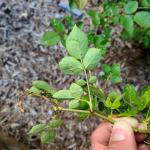
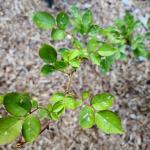 Roseslugs: Two species of sawfly can be found on the leaves of roses at this time. These small, caterpillar-like larvae will skeletonize the upper leaf surface and leave a “window-pane” like pattern behind. When present in large numbers, these insects are capable of defoliating their entire host. Management options include an insecticidal soap spray or a product containing spinosad. Roseslug sawflies were viewed in Hinsdale, MA on 6/7/2020.
Roseslugs: Two species of sawfly can be found on the leaves of roses at this time. These small, caterpillar-like larvae will skeletonize the upper leaf surface and leave a “window-pane” like pattern behind. When present in large numbers, these insects are capable of defoliating their entire host. Management options include an insecticidal soap spray or a product containing spinosad. Roseslug sawflies were viewed in Hinsdale, MA on 6/7/2020.
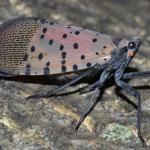 Spotted Lanternfly: (Lycorma delicatula, SLF) is not known to occur in Massachusetts landscapes (no established populations are known in MA at this time). However, due to the great ability of this insect to hitchhike using human-aided movement, it is important that we remain vigilant in Massachusetts and report any suspicious findings. Spotted lanternfly reports can be sent here:https://massnrc.org/pests/slfreport.aspx
Spotted Lanternfly: (Lycorma delicatula, SLF) is not known to occur in Massachusetts landscapes (no established populations are known in MA at this time). However, due to the great ability of this insect to hitchhike using human-aided movement, it is important that we remain vigilant in Massachusetts and report any suspicious findings. Spotted lanternfly reports can be sent here:https://massnrc.org/pests/slfreport.aspx
For a map of known, established populations of SLF as well as detections outside of these areas where individual finds of spotted lanternfly have occurred (but no infestations are present), visit: https://nysipm.cornell.edu/environment/invasive-species-exotic-pests/spotted-lanternfly/ This map depicts an individual find of spotted lanternfly at a private residence in Boston, MA that was reported by the MA Department of Agricultural Resources on February 21, 2019. More information about this detection in Boston, where no established infestation was found, is provided here: https://www.mass.gov/news/state-agricultural-officials-urge-residents-to-check-plants-for-spotted-lanternfly
This insect is a member of the Order Hemiptera (true bugs, cicadas, hoppers, aphids, and others) and the Family Fulgoridae, also known as planthoppers. The spotted lanternfly is a non-native species first detected in the United States in Berks County, Pennsylvania and confirmed on September 22, 2014.
The spotted lanternfly is considered native to China, India, and Vietnam. It has been introduced as a non-native insect to South Korea and Japan, prior to its detection in the United States. In South Korea, it is considered invasive and a pest of grapes and peaches. The spotted lanternfly has been reported from over 70 species of plants, including the following: tree of heaven (Ailanthus altissima) (preferred host), apple (Malus spp.), plum, cherry, peach, apricot (Prunus spp.), grape (Vitis spp.), pine (Pinus spp.), pignut hickory (Carya glabra), sassafras (Sassafras albidum), serviceberry (Amelanchier spp.), slippery elm (Ulmus rubra), tulip poplar (Liriodendron tulipifera), white ash (Fraxinus americana), willow (Salix spp.), American beech (Fagus grandifolia), American linden (Tilia americana), American sycamore (Platanus occidentalis), big-toothed aspen (Populus grandidentata), black birch (Betula lenta), black cherry (Prunus serotina), black gum (Nyssa sylvatica), black walnut (Juglans nigra), dogwood (Cornus spp.), Japanese snowbell (Styrax japonicus), maple (Acer spp.), oak (Quercus spp.), and paper birch (Betula papyrifera).
The adults and immatures of this species damage host plants by feeding on sap from stems, leaves, and the trunks of trees. In the springtime in Pennsylvania (late April - mid-May) nymphs (immatures) are found on smaller plants and vines and new growth of trees and shrubs. Third and fourth instar nymphs migrate to the tree of heaven and are observed feeding on trunks and branches. Trees may be found with sap weeping from the wounds caused by the insect’s feeding. The sugary secretions (excrement) created by this insect may coat the host plant, later leading to the growth of sooty mold. Insects such as wasps, hornets, bees, and ants may also be attracted to the sugary waste created by the lanternflies, or sap weeping from open wounds in the host plant. Host plants have been described as giving off a fermented odor when this insect is present.
Adults are present by the middle of July in Pennsylvania and begin laying eggs by late September and continue laying eggs through late November and even early December in that state. Adults may be found on the trunks of trees such as the tree of heaven or other host plants growing in close proximity to them. Egg masses of this insect are gray in color and look similar in some ways to gypsy moth egg masses.
Host plants, bricks, stone, lawn furniture, recreational vehicles, and other smooth surfaces can be inspected for egg masses. Egg masses laid on outdoor residential items such as those listed above may pose the greatest threat for spreading this insect via human aided movement.
For more information about the spotted lanternfly, visit this fact sheet: https://ag.umass.edu/landscape/fact-sheets/spotted-lanternfly .
- Taxus Mealybug: Dysmicoccus wistariae will produce honeydew and lead to sooty mold growth, yellowing of needles, and sparsely foliated plants. Eventual dieback may be possible. This species is commonly associated with taxus in New England, but can be occasionally found on dogwood, rhododendron, Prunus spp., maple, andromeda, and crabapple. These mealybugs are found on stems and branches and particularly like to congregate at branch crotches. Taxus mealybug feeds in the inner bark tissue of the trunk and branches. Adult females are present from June to August and give birth to living young in the summer. Immatures overwinter. A single generation may occur per year in New England, but areas to the south can have multiple generations of this insect. Management may be targeted between 246-618 GDD’s, base 50°F. Horticultural oil and neem oil may be used.
- Twolined Chestnut Borer: Agrilus bilineatus is a native jewel beetle (also known as a flatheaded borer) in the Family Buprestidae. This insect is also in the same genus as the invasive emerald ash borer. The twolined chestnut borer is native to Massachusetts, much of New England, and the eastern United States. This species has one generation per year and adults are typically active from April – August, depending upon location and temperature. Adults will conduct some maturation feeding on oak prior to mating. Females will lay clusters of tiny eggs in the cracks and crevices of bark. Larvae hatch from the eggs in 1-2 weeks and burrow through the bark into the cambium, where they feed in a similar manner to the emerald ash borer, creating meandering galleries as they feed. (The galleries of the twolined chestnut borer can be straight in very stressed trees.) Larvae typically mature by August – October and burrow to the outer bark where they create a chamber in which they overwinter. Pupation occurs the following spring and adults emerge through D-shaped exit holes that are approximately 1/5 inch wide. In the northern extent of this insect’s range, they can take 2 years to complete their life cycle. Larvae of this insect have been recorded from eastern white oak, common post oak, burr oak, scarlet oak, northern red oak, and eastern black oak. Adults have been recorded on fir and pin oak. These insects are attracted to stressed host plants and typically become a secondary factor in the decline of the tree.
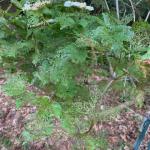

Viburnum Leaf Beetle: Pyrrhalta viburni is a beetle in the family Chrysomelidae that is native to Europe, but was found in Massachusetts in 2004. Viburnum leaf beetle overwinters as eggs laid in capped pits on the newest growth of susceptible viburnum branches. Egg hatch occurs in late-April to early-May as temperatures warm and foliage becomes available. Monitor for larvae in mid-May (80-120 GDD’s). Reports of viburnum leaf beetle larval feeding to UMass Extension have increased, likely because feeding damage became more apparent. Feeding larvae were seen and reported on 5/31/20 in Southampton, MA and Pelham, MA. This beetle feeds exclusively on many different species of viburnum, which includes, but is not limited to, susceptible plants such as V. dentatum, V. nudum, V. opulus, V. propinquum, and V. rafinesquianum. Some viburnum have been observed to have varying levels of resistance to this insect, including but not limited to V. bodnantense, V. carlesii, V. davidii, V. plicatum, V. rhytidophyllum, V. setigerum, and V. sieboldii. More information about viburnum leaf beetle may be found at http://www.hort.cornell.edu/vlb/ .
Concerned that you may have found an invasive insect or suspicious damage caused by one? Need to report a pest sighting? If so, please visit the Massachusetts Introduced Pests Outreach Project: http://massnrc.org/pests/pestreports.htm .
A note about Tick Awareness: deer ticks (Ixodes scapularis), the American dog tick (Dermacentor variabilis), and the lone star tick (Amblyomma americanum) are all found throughout Massachusetts. Each can carry their own complement of diseases. Anyone working in tick habitats (wood-line areas, forested areas, and landscaped areas with ground cover) should check themselves regularly for ticks while practicing preventative measures. Have a tick and need it tested? Visit the web page of the UMass Laboratory of Medical Zoology https://www.tickreport.com/ and click on the blue Order a TickReport button for more information.
Reported by Tawny Simisky, Extension Entomologist, UMass Extension Landscape, Nursery, & Urban Forestry Program
Weeds
Summer annual grass and broadleaf weeds are becoming increasingly more apparent in mulched landscape beds. Most summer annuals have germinated and the recent hot weather has allowed them to get large. Some weeds have become sizable and spraying them will result in unsightly dead vegetation, so hand weeding may be necessary. However, spot spraying with a non-selective herbicide is usually a better strategy than hand-weeding because it does not break the mulch barrier unless the plant is clipped below the stem base. Determination on a site-by-site basis will be needed to select the best strategy. Inspect the mulch layer to ensure that it is thick enough to control future weed problems.
Many landscape trees commonly produce vegetative suckers at their trunk base. Suckers are commonly seen on crabapple, flowering cherry, flowering pear, plum, linden, maple and sometimes oak. Honey locust commonly produces vegetative sprouts along the entire length of their trunk. It these suckers or sprouts are not controlled, the landscape will be a contender for the “shabby landscape award”. Pruning is effective but very time consuming. Another option would be to use the product ScytheTM that contains pelargonic acid to remove these vegetative suckers and sprouts when they are very small. Very small means less than one inch in length or smaller. Pelargonic acid is a contact herbicide. If ScytheTM is applied to small suckers and sprouts, the product will desiccate them and physical removal will not be required. Larger growth will first need to be physically removed and then ScytheTM can be used as a maintenance program. Products that contain glyphosate should not be used, as glyphosate is a translocated herbicide and injury is possible.
Do not delay, treat garlic mustard, Alliaria petiolata, now. Plants have matured to a point were seedpods have formed but the seeds are not yet mature as they are still green. Garlic mustard is a biennial and herbicide applications at this time of year will control second-year plants before they go to seed as well as the first-year seedlings.
New growth expansion of poison ivy continues. Poison ivy is flowering so it should be treated now. Application can be done from now to mid-September.
Do not attempt to control Japanese knotweed, Polygonum cuspidatum, currently as herbicide applications are not effective. In preparation for a late season herbicide application, cut or mow stands of knotweed to the ground in late May and early June. This practice is done to facilitate herbicide application by removing the dried stems from the previous year’s growth and will control plant height so knotweed will be shorter at time of treatment in late summer. There is also some indication that the plant’s carbohydrate reserves may be reduced with this early season mowing.
Report by Randy Prostak, Weed Specialist, UMass Extension Landscape, Nursery and Urban Forestry Program
Landscape Practices
With half of Massachusetts in a "Moderate Drought" as of 6/23, according to the US Drought Monitor (https://droughtmonitor.unl.edu/CurrentMap/StateDroughtMonitor.aspx?MA), it is important to irrigate as efficiently as possible. The following tips will help ensure that irrigation applications are as beneficial as possible.
1. Be aware of, and follow, your local town or municipality water regulations.
2. Don’t irrigate midday. Evaporation is greatest midday, which could mean that much of the water being applied is lost before it reaches plants! Wind also contributes to evaporation and can change irrigation spray patterns. Early morning and evening are the best times to irrigate.
3. Use drip irrigation or soaker hoses when possible. Overhead irrigation frequently results in watering non-plant surfaces and can result in water interception by plant canopies which can reduce the water that reaches the plants’ root systems.
4. Maintain your irrigation system. Check for leaks, broken spray heads, and perform an irrigation system audit to assure uniformity.
5. Use smart technology. Smart controllers can monitor soil moisture and use environmental conditions to adjust irrigation based on water being lost to evapotranspiration (evaporation and transpiration).
6. Water deeply, allowing water to soak into the ground. Irrigating slowly (via drip irrigation or a slow flow) is key to achieving infiltration vs. runoff. Newly installed plants will need more frequent irrigation until established, especially container grown plants that were produced in soilless substrates. Less frequent, deeper irrigation encourages good root growth which will help plants survive water stress.
7. Apply mulch to planting beds and in tree rings 2-4” deep. Keep mulch away from the base of plants and trees. Mulch helps reduce evaporation, insulates plant roots, and can add organic matter to the soil.
8. Raise your mower blade. Longer grass promotes deeper roots and a more drought-resistant lawn.
9. Reduce the competition for water by controlling weeds.
10. Don’t apply fertilizer under drought conditions. High fertilizer concentration can make available water unavailable to plants. Fertilization will also result in increased growth which increases the water demand.
11. Keep in mind that landscapes typically require one inch of water per week (including rainfall). Unsure of what your system or sprinkler is applying? You can use a rain gauge and see how much water is collected in a certain period of time (30 minutes for example). Use multiple rain gauges if possible to understand if you have good uniformity, or make sure the rain gauge is located in an “average area”.
Report by Mandy Bayer, Extension Assistant Professor of Sustainable Landscape Horticulture, UMass Stockbridge School of Agriculture
Additional Resources
To receive immediate notification when the next Landscape Message update is posted, join our email list by emailing your request to eweeks@umext.umass.edu with Subscribe Greeninfo in the subject line, and follow us on Facebook and Twitter.
For a complete listing of upcoming events, see our upcoming educational events https://ag.umass.edu/landscape/upcoming-events
For commercial growers of greenhouse crops and flowers - Check out UMass Extension's Greenhouse Update website
For professional turf managers - Check out Turf Management Updates
For home gardeners and garden retailers - Check out our home lawn and garden resources. UMass Extension also has a Twitter feed that provides timely, daily gardening tips, sunrise and sunset times to home gardeners at twitter.com/UMassGardenClip
Diagnostic Services
A UMass Laboratory Diagnoses Landscape and Turf Problems - The UMass Extension Plant Diagnostic Lab is available to serve commercial landscape contractors, turf managers, arborists, nurseries and other green industry professionals. It provides woody plant and turf disease analysis, woody plant and turf insect identification, turfgrass identification, weed identification, and offers a report of pest management strategies that are research based, economically sound and environmentally appropriate for the situation. Accurate diagnosis for a turf or landscape problem can often eliminate or reduce the need for pesticide use. For sampling procedures, detailed submission instructions and a list of fees, see Plant Diagnostics Laboratory
Soil and Plant Nutrient Testing - The University of Massachusetts Soil and Plant Nutrient Testing Laboratory is located on the campus of The University of Massachusetts at Amherst. Testing services are available to all. The function of the Soil and Plant Nutrient Testing Laboratory is to provide test results and recommendations that lead to the wise and economical use of soils and soil amendments. For complete information, visit the UMass Soil and Plant Nutrient Testing Laboratory web site. Alternatively, call the lab at (413) 545-2311.
Ticks are active any time that temperatures are above freezing! Remember to take appropriate precautions when working and playing outdoors, and conduct daily tick checks. UMass tests ticks for the presence of Lyme disease and other disease pathogens. Learn more
